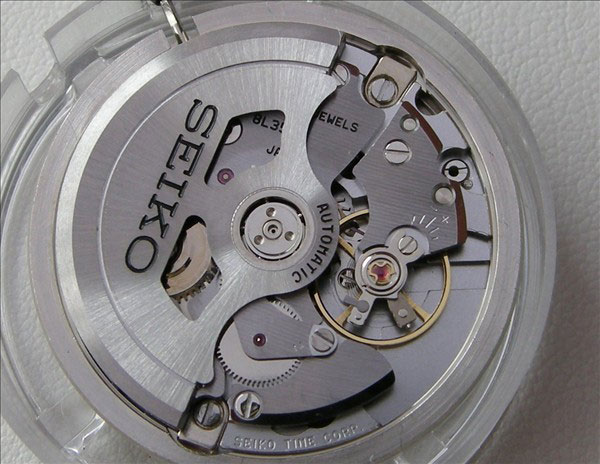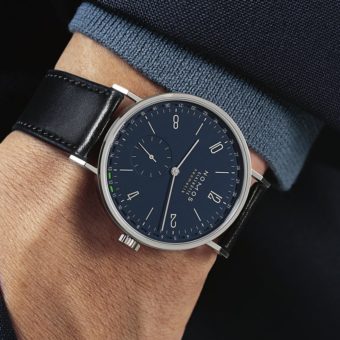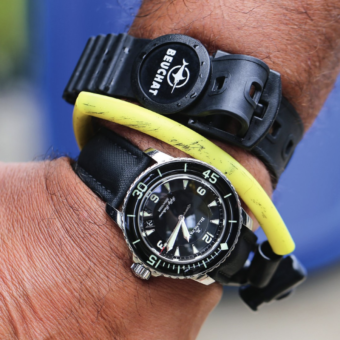This week we take a look at a watch that is either one of the most beloved or — I suppose the word would be unloved — models on the market today, depending on whom you ask. I am talking about none other than the Seiko “Tuna,” or (as it more commonly listed today) the Seiko Marinemaster Professional 1000m Automatic Diver.
This watch is one of the most important in Seiko’s long history of diving watches, a contemporary version of one of the models most appreciated by the brand’s enthusiasts, commonly known by the nickname “Tuna” or “Tuna Can” (as a result of its tuna-can-like case appearance). The lineage of these Seiko divers began in 1965 with the brand’s first diving watch (pictured below): a steel, automatic, 150-meter water-resistant piece with long, sturdy lugs, a large crown, and massive rectangular hour markers. This piece, regarded among enthusiasts as a cherished relic in the history of both horology and diving, was quickly replaced by better-performing models over the next few years — among them the Professional Diver’s 600m watch, also known as the world’s first Seiko Tuna (pictured above).
This first Seiko Professional Diver’s 600m, released in 1975, offered a variety of world-class improvements not previously seen in diving watches that preceded it. These included its being the first dive watch that used a titanium case, as well as one of the first that used a two-layered case for better protection and which allowed for the lack of a helium valve. Its innovative rubber strap expanded or contracted to best fit a diving suit at various depths. This piece, as Seiko is apt to point out, was granted more than 20 patents upon its release, and was well manufactured for the abuse that such tool watches endured during dives.
Today’s modern Seiko Tuna, the Ref. SBDX013 (above) — one among a few other modern references including the SBDX011 and SBDX014 (below) — is a watch with some very obvious historical influences. This 48.2-mm beast has a screwed-in, integrated titanium-and-steel case, housing inside it the highly accurate automatic Seiko Caliber 8L35, a rather durable automatic movement, produced in-house by Seiko. The movement boasts a 50-hour power reserve and a hack function via the screw-down crown. On top of this undeniably masculine case sits a familiar unidirectional diving bezel, and further within the bezel is a dial with a design that is uniquely Seiko. The dial features highly luminescent circle hour markers, with a rounded triangle at the 12 o’clock mark, a date indicator at the 3 o’clock position, and the watch’s description toward the bottom of the dial. Also note the fascinating Seiko-specific hour and minute hands, along with the classic lollipop seconds hand sweeping over the dial. This piece is currently listed on Seiko’s website for $3,300, but it can occasionally be found for a bit less at a dealer.
Comparing this modern watch to its vintage counterpart, it would be easy to forgive someone who confused the two. From the interesting dial, hands, bezel, case, and even to the rubber strap, this modern Seiko diver makes no attempt to hide its lineage within a modern styling. Truly, the two watches share much more commonalities than they share differences. For example, notice the slight dips towards the upper right and lower left parts of the front-facing case. These dips are to assist deep-sea divers better move the bezel underwater, while the non-dipped parts of the case add further protection from underwater mayhem. This is a very small detail, but one shared nonetheless by both the historical and contemporary pieces.
The only obvious differences between the two watches are in the functionality of their movements (modern technology and manufacturing does bring better accuracy), and in the depth rating improvement from 600 meters on the vintage model to 1000 meters on the new. Of course, since humans can only dive unassisted to depths of about 275 meters at most, this enhanced depth rating is more about bragging rights than field practicality. Other differences include a more matte and professional-looking finishing on the case, a slightly smaller case diameter (from 51 mm to 48.2 mm), a smaller black crown as compared to a previously steel one, and a change in the tool needed to unscrew the four pieces holding the watch together.
Most brands with historically inspired watch series have to actively work towards developing such vintage re-interpretations or recreations. This cannot be said for the Seiko Tuna. This is a watch that, through the past few decades, has more or less stuck to the design codes that first made it appealing to deep-sea dwellers and desk divers alike around the world. And this element of consistency is no mistake or coincidence: when Seiko first produced this watch in 1975, the company offered what it felt was the best diving watch available based purely on the watch’s design and construction. Most likely, Seiko has not yet found a watch design more effective to withstand the pressures at the very bottom of the ocean. The only changes that have come to the watch have been minuscule and for practical purposes — a smaller, more hidden crown; a brighter and more luminescent dial; a slightly smaller case so the watch can be worn under a dress shirt cuff rather than just around a dive suit sleeve. Aesthetically, the modern Seiko Tuna may not be the most universally loved watch out there, but it is undeniably, and deservedly in my opinion, regarded as the heir to one of dive watch history’s great icons as well as a solid example of a contemporary watch with historical ties.
For our most recent article, in which I compare the modern Tudor Heritage Chrono Blue to its vintage counterpart, click here.
Caleb Anderson is a freelance writer for various publications. Since first learning about horology, he has garnered extensive knowledge on vintage watches, and spends much of his time sharing his opinions within the field. Currently located near New York City, he is a persistent student in all things historical, a writer on many topics, and a casual runner.













Actually the watch is a bit larger at 52.4 mm . I have the SBDX014
The 8L35 movement in this 1000M Seiko is the best of the best !
The movement is an undecorated Grand Seiko movement.
It has 26 jewels and has hacking….. also can be hand wound if required.
It also has a built in feature where it can’t be over wound.
I have one for a couple of years now and it gains + 1/2 sec a day which is chronometer grade although it doesn’t say that on the movement.
The quality is outstanding and it is in a category of it’s own… not to be compared to the lesser Seiko Diver Models… but is the best diver watch in the world from my own research.
This is a watch that cannot be worn unless one has short sleeves…it’s “too thick” for daily long sleeve use……absolutely !
If this watch is used professionally…..it should be pressure tested every three years by “Seiko Service Center Only”……to keep up the watch performance and safety while diving….they will make the decision if the seals need replacement.
It’s a watch that will last a lifetime….if taken care of !
I am curious if this movement can be wound. I know some of theirs cannot and thus must be worn to wind.
While I don’t have this watch, I believe it’s only their basic 7S26/7S36 models that can’t be handwound. The Monster (one step up from the SKX007/009) uses the 4R36 movement that hacks and handwinds. The MM1000 uses an undecorated version of their Grand Seiko movement, so it also hacks and handwinds.